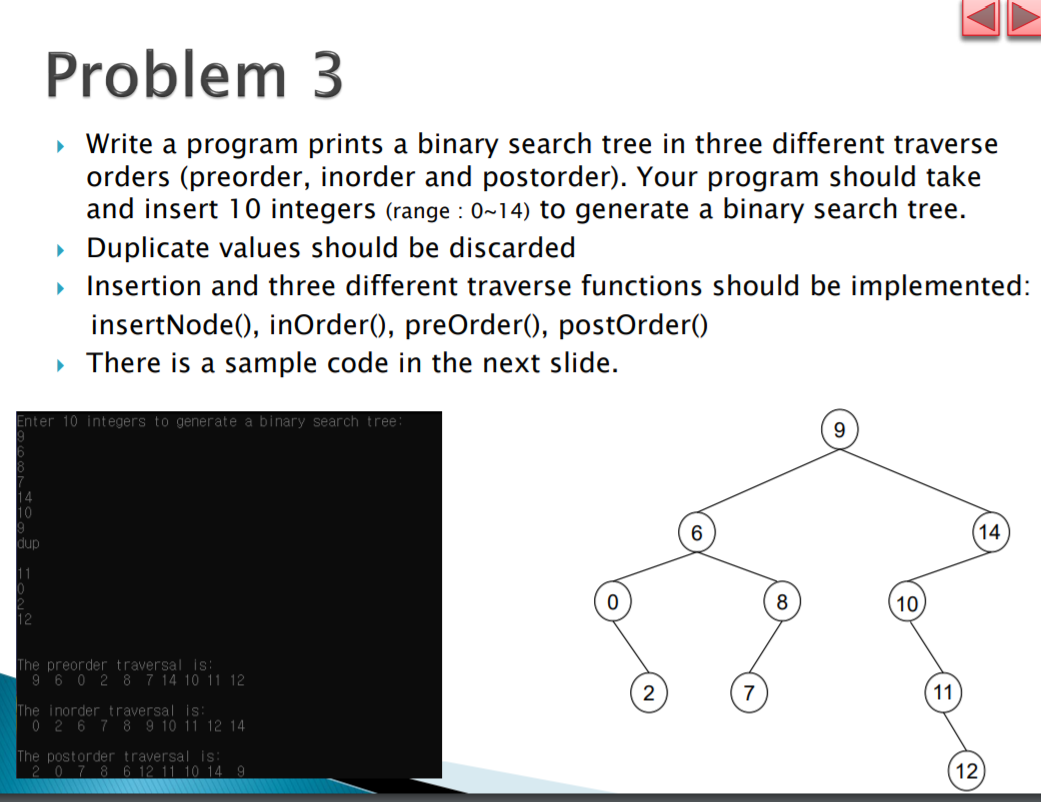
HOW TO WRITE C CODE FOR A BINARY TREE CODE
Programmers write computer code and this is converted by a translator into binary instructions that the processor can execute. Each instruction is translated into machine code - simple binary codes that activate the CPU. The digits 1 and 0 used in binary reflect the on and off states of a transistor.

How does a computer interpret binary code? Advantages of this type of observation are that if you are studying natural behaviour they have high ecological validity. For example, 10011 represents (1 X 24) + (0 X 23) + (0 X 22) + (1 X 21) + (1 X 20), or 16 + 0 + 0 + 2 + 1, or 19.Ĭoding schemes are ways of categorising behaviour so that you can code what you observe in terms of how often a type of behaviour appears.
HOW TO WRITE C CODE FOR A BINARY TREE HOW TO
Each successive digit represents a power of 2. My question is how to write correctly and iteratively the part of the code that will store the numbers in the tree (. A method of representing numbers that has 2 as its base and uses only the digits 0 and 1. The binary code assigns a pattern of binary digits, also known as bits, to each character, instruction, etc.Īdditionally, what is binary system example? binary number system.

The two-symbol system used is often "0" and "1" from the binary number system. In this regard, what is the purpose of the binary coding system?Ī binary code represents text, computer processor instructions, or any other data using a two-symbol system. The common coding schemes are ASCII, EBCDIC, and UNICODE. This allows the application to easily search for database rows by specifying a key, for example, to find a user record using the email primary key.A CODING SCHEME is a convention that associates each character from character set with a unique bit pattern -a binary representation of the integers from 0. There are many applications of binary search trees in real life, and one of the most common use cases is storing indexes and keys in a database.įor example, when you create a primary key column in MySQL or PostgresQL, you create a binary tree where the keys are the values of the column and the nodes point to database rows. For example, getting a user record by the email primary key. This lets the application easily search database rows by providing a key. There are many applications of binary search trees in real life, and one of the most common use-cases is in storing indexes and keys in a database.įor example, in MySQL or PostgresQL when you create a primary key column, what you’re really doing is creating a binary tree where the keys are the values of the column, and those nodes point to database rows. Where would you use a binary search tree in real life? The exists function is another simple recursive function that returns True or False depending on whether a given value already exists in the tree. This allows a parent whose child has been deleted to properly set it’s left or right data member to None. It is a recursive function as well, but it also returns the new state of the given node after performing the delete operation. The delete operation is one of the more complex ones. Since pointers to whole objects are typically involved, a BST can require quite a bit more memory than an array, although this depends on the implementation.When the tree becomes unbalanced, all fast O(log(n)) operations quickly degrade to O(n).If you need to iterate over each node, you might have more success with an array. An ordinary BST, unlike a balanced tree like a red-black tree, requires very little code to get running. The problem of creating a duplicate tree can be broken down to sub problems of creating duplicate sub trees. We will traverse the binary tree using pre order traversal and create a clone of every node. Binary search trees are pretty simple. Given a binary tree, we have to create a clone of given binary tree.When balanced, a BST provides lightning-fast O(log(n)) insertions, deletions, and lookups.Many popular production databases such as PostgreSQL and MySQL use binary trees under the hood to speed up CRUD operations. A binary tree where the left child contains only nodes with values less than the parent node, and where the right child only contains nodes with values greater than or equal to the parent.

Binary tree: Tree where each node has up to two leaves. Log(n) is much faster than the linear O(n) time required to find elements in an unsorted array. This is not binary tree, it is binary search tree. To be precise, binary search trees provide an average Big-O complexity of O(log(n)) for search, insert, update, and delete operations. This arrangement of nodes lets each comparison skip about half of the rest of the tree, so the entire search is lightning fast. Writing a Binary Search Tree in Python with ExamplesĪ binary search tree, or BST for short, is a tree whose nodes store a key that is greater than all of their left child nodes and less than all of their right child nodes.īinary trees are useful for storing data in an organized manner so that it can be quickly retrieved, inserted, updated, and deleted.


 0 kommentar(er)
0 kommentar(er)
